Understanding macros is the first step to achieving any health goal, whether it is fat loss, muscle gains, or simply feeling more energetic. Counting calories shows quantity. Macro balance shows fuel quality.

The importance of balancing macros
You can count calories to see how many you consume, but balancing your macros tells you the type of fuel you give your body. With a balanced macro pattern you tend to feel more energetic, manage appetite better, and support performance and recovery.
- Why balance is important and what each macro can do
- How to calculate and customize your ratio
- Visuals of a macro plate for planning meals
- Examples of meals for various goals
- Expert tips and FAQs

One. Energy that lasts the day
Fats provide steady energy and carbohydrates provide quick fuel. Balancing both with sufficient protein helps curb cravings.
Two. Stronger muscles and quicker recovery
Protein repairs muscle fibers. Training without adequate protein limits strength and growth.
Three. Sharper brain and better mood
Omega-3 fats support cell signaling and serotonin pathways that influence focus and emotional stability.
Four. Easier weight management
Macro patterns influence hunger hormones like ghrelin and leptin. Balanced meals often reduce appetite naturally.
Five. Better metabolic flexibility
A good mix improves the body’s ability to burn either carbohydrates or fats efficiently.
What are macronutrients? The foundation of your diet
The macronutrients are those your body requires in larger amounts. They are the main building blocks of your diet and they support nearly all metabolic functions.
| Macronutrient | Core function | Calories per gram | Healthful sources |
|---|---|---|---|
| Protein | Builds tissue, supports immunity, preserves muscle mass | 4 kcal | Tofu, eggs, chicken, fish, lentils |
| Carbohydrates | Primary energy for brain and muscles | 4 kcal | Fruits, vegetables, oats, brown rice |
| Fats | Hormone regulation, brain support, nutrient absorption | 9 kcal | Avocado, nuts, olive oil, seeds |
You can survive short periods without food, but the right macro ratio determines how well your body functions day to day.
Step 1. Calculate your daily calorie need
Before dividing macros, set a daily calorie target. Estimate your expenditure using the Calories Calculator by entering age, gender, height, weight, and activity level.
Example: A 30-year-old woman, 65 kg, moderately active, may maintain at about 2,000 kcal per day.
Step 2. Choose your goal and macro ratio
| Goal | Protein | Carbs | Fats | What it does |
|---|---|---|---|---|
| Weight loss | 35–40% | 30–35% | 25–30% | Higher protein supports fullness and muscle retention |
| Muscle gain | 30–35% | 45–50% | 20–25% | Protein and carbs support growth and training |
| Maintenance | 25–30% | 40–50% | 20–30% | Balanced intake for energy and focus |
| Low carb or keto | 25–30% | 5–10% | 60–70% | Use with professional guidance |
Example: 2,000 kcal split at 40/30/30
- Carbohydrates: 40% = 800 kcal = 200 g
- Protein: 30% = 600 kcal = 150 g
- Fats: 30% = 600 kcal ≈ 67 g

Step 3. Visualize your macro plate
- Half plate complex carbs with fiber: beans, brown rice, sweet potato, vegetables
- One quarter lean protein: chicken, fish, tofu, eggs, lentils
- One quarter healthy fats: avocado, olive oil, nuts and seeds
Knowing each macro
Protein, your structural hero
- Recommended intake: about 1.2 to 2.0 g per kg body weight
- Best sources: eggs, Greek yogurt, lentils, tofu, poultry, fish
- Benefits: muscle repair, hormone production, immune defense
- Low intake signs: fatigue, hair loss, low immunity
- Tip: spread protein across meals, about 20 to 30 g per serving
Carbohydrates, reliable fuel
- Primary energy for brain and muscle
- Quality matters more than quantity alone
- Complex carbs: oats, quinoa, beans, vegetables
- Limit refined carbs: white bread, sugary snacks, soda
- Average adult often targets 45 to 55% of daily calories
- Plan with the Carbohydrates Calculator
- Aim for 25 to 35 g fiber daily and combine carbs with protein or fat to smooth glucose response
Fats, essential and supportive
- Support skin, joints, and hormone balance
- Unsaturated fats: olive oil, nuts, seeds, avocado
- Keep saturated fats under about 10% of total calories
- Avoid trans fats completely
- Daily need often 20 to 30% of total calories
- Omega-3 sources: flaxseed and walnuts can help reduce inflammation
Macro tracking made easy
- Use trusted apps such as Cronometer or MyFitnessPal
- Hand guide: palm equals a protein portion, fist equals a carb portion, thumb equals a fat portion
- Cook more at home to control ingredients and oils
- Review weekly and adjust based on energy, body composition, and goals
- Plan with the Calories Calculator and the Carbohydrates Calculator
Macro balanced meals sample
| Meal | Protein | Carbs | Fats | Example |
|---|---|---|---|---|
| Breakfast | 25 g | 40 g | 10 g | Oatmeal with protein powder, berries, and nuts |
| Snack | 15 g | 20 g | 8 g | Greek yogurt with banana and chia seeds |
| Lunch | 35 g | 45 g | 15 g | Grilled chicken, brown rice, avocado, mixed vegetables |
| Snack | 10 g | 15 g | 12 g | Boiled eggs with a handful of almonds |
| Dinner | 30 g | 40 g | 18 g | Baked fish, sweet potato, olive oil salad |
The most common macro mistakes and how to fix them
| Mistake | Impact | Quick fix |
|---|---|---|
| Cutting fats completely | Hormone imbalance and fatigue | Include olive oil or avocado daily |
| Skipping protein at breakfast | Energy crashes and cravings | Add eggs or Greek yogurt |
| Relying on processed carbs only | Frequent glucose spikes | Choose whole grains and fruit |
| Ignoring fiber | Poor digestion | Add vegetables and beans at each meal |
| Overusing protein supplements | Unnecessary calories | Prioritize whole foods first |
The best macro techniques for maximum results
- Cycle carbohydrates. Less on rest days and more on heavy training days
- Include micronutrients. Macros still need vitamins and minerals
- Hydrate well. About one liter per 25 kg body weight
- Sleep 7 to 8 hours for better recovery and macro utilization
- Reevaluate monthly and recalculate as body composition changes
References with science based sources
Many people ask questions
What is the simplest starter macro ratio?
A balanced split such as 30% protein, 40% carbs, and 30% fats is simple to follow for many beginners.
How quickly will I feel changes?
Most people notice better energy and fewer cravings within one to two weeks, with gradual body composition changes following.
Do I need to weigh every ingredient?
Not always. Hand guides and consistent meal patterns are practical. Use calculators for more precise planning when needed.
Is keto suitable for everyone?
Keto can help some people but is not universal. Speak with a professional if you have medical conditions or take medication.
Are supplements required?
Start with whole foods. Add supplements only to cover clear gaps or based on clinical advice.
How can vegetarians meet protein goals?
Combine plant proteins such as tofu, lentils, and nuts. Pair grains like quinoa with dairy or soy to round out amino acids.
Building a balanced lifestyle
Macro balance is not restriction. It is precision that gives freedom. Once you understand portions and numbers, healthy eating becomes easier.
- Calculate your daily target with the Calories Calculator
- Plan intake with the Carbohydrates Calculator
- Build macro plates with whole foods in varied colors
- Expect better energy, focus, and relationship with food in a few weeks
About the Author
This article is written by the NutriFitCalc Team, a group of Food Science and Nutrition students who create simple, research-backed guides for healthy living.
We review global health sources like WHO and CDC to keep our content accurate and helpful.
